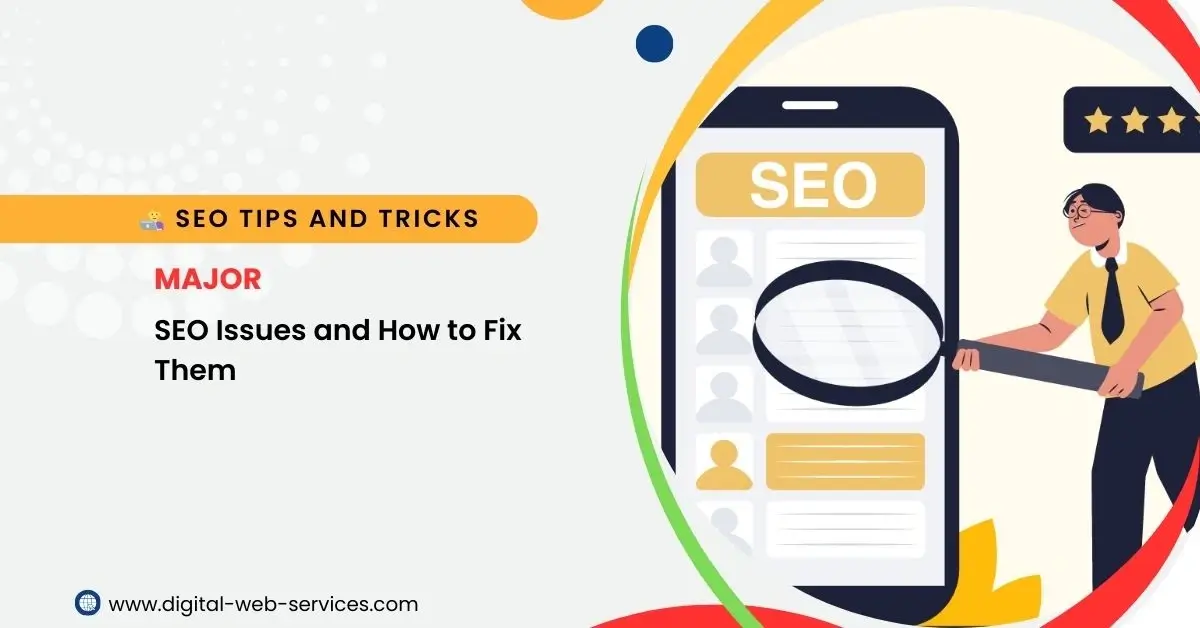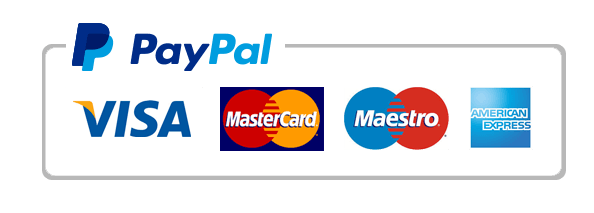
Here are the major SEO issues we encounter while optimizing a website. In this article, you’ll learn about these problems along with easy step-by-step solutions to fix them:
Explore the Major SEO Issues Examples
Duplicate Content
Problem: Duplicate content confuses search engines and can negatively affect rankings.
Fix:
- Step 1: Use tools like Screaming Frog or Copyscape to identify duplicate content.
- Step 2: Implement canonical tags on the duplicate pages, pointing to the main content.
- Step 3: Use 301 redirects for duplicate URLs to consolidate link equity.
Slow Page Load Speed
Problem: Slow page speeds result in a poor user experience and higher bounce rates.
Fix:
- Step 1: Use tools like Google PageSpeed Insights or GTmetrix to test your site’s speed.
- Step 2: Compress large images using TinyPNG or ImageOptim.
- Step 3: Minify CSS, JavaScript, and HTML code using UglifyJS or CSSMinifier.
- Step 4: Implement a CDN (Content Delivery Network) to improve speed for global visitors.
Broken Links (404 Errors)
Problem: Broken links hurt SEO and the user experience.
Fix:
- Step 1: Run a site audit with Screaming Frog or Google Search Console to find broken links.
- Step 2: Update or remove broken links.
- Step 3: Implement 301 redirects to correct broken URLs.
Mobile-Friendliness Issues
Problem: Google prioritizes mobile-friendly websites for ranking.
Fix:
- Step 1: Use Google’s Mobile-Friendly Test to check your site’s mobile compatibility.
- Step 2: Implement responsive web design to ensure your site adapts to all screen sizes.
- Step 3: Test your mobile site’s speed and optimize accordingly.
Thin Content
Problem: Pages with little or no content don’t rank well.
Fix:
- Step 1: Identify pages with low content using Google Analytics or Screaming Frog.
- Step 2: Expand content to answer user queries thoroughly and add relevant keywords.
- Step 3: Ensure content is at least 500-1000 words for blog posts or landing pages.
Missing or Poor Meta Tags
Problem: Missing or poorly optimized meta tags result in lower CTR.
Fix:
- Step 1: Use Screaming Frog to identify missing or duplicate meta tags.
- Step 2: Write unique meta titles and meta descriptions for each page, using target keywords.
- Step 3: Ensure meta tags are compelling and under 60 characters for titles and 160 characters for descriptions.
Incorrect Use of Heading Tags
Problem: Misused heading tags confuse search engines and users.
Fix:
- Step 1: Ensure H1 is used only once on each page and contains the primary keyword.
- Step 2: Structure other headings (H2, H3, H4) logically, organizing content hierarchically.
- Step 3: Avoid skipping heading levels (e.g., jumping from H1 to H3).
Lack of Structured Data (Schema Markup)
Problem: Missing structured data can lead to lower visibility in search results.
Fix:
- Step 1: Use Google’s Structured Data Markup Helper to implement schema for rich snippets.
- Step 2: Add schema for reviews, products, articles, and other relevant content.
- Step 3: Validate your structured data using Google’s Structured Data Testing Tool.
Content Cannibalization
Problem: Multiple pages targeting the same keyword may hurt SEO.
Fix:
- Step 1: Identify cannibalized keywords using Google Search Console or Ahrefs.
- Step 2: Merge similar content into a single, more comprehensive page.
- Step 3: Use 301 redirects to direct traffic from the old pages to the consolidated page.
Crawl Errors
Problem: Search engines cannot access important pages.
Fix:
- Step 1: Check for crawl errors in Google Search Console.
- Step 2: Fix errors by updating broken links, removing or redirecting inaccessible pages.
- Step 3: Re-submit the sitemap after fixing the errors.
Missing XML Sitemap
Problem: Without an XML sitemap, search engines may miss important pages.
Fix:
- Step 1: Generate an XML sitemap using Yoast SEO (for WordPress) or Screaming Frog.
- Step 2: Submit the sitemap to Google Search Console and Bing Webmaster Tools.
- Step 3: Ensure the sitemap is updated whenever you add new content.
Bad URL Structure
Problem: Long, complex URLs hurt SEO.
Fix:
- Step 1: Keep URLs clean, short, and descriptive.
- Step 2: Use hyphens (-) instead of underscores (_) to separate words.
- Step 3: Include relevant keywords in the URL, but avoid keyword stuffing.
Keyword Stuffing
Problem: Overuse of keywords can lead to penalties.
Fix:
- Step 1: Focus on user intent and naturally integrate keywords.
- Step 2: Use LSI (Latent Semantic Indexing) keywords and related terms.
- Step 3: Maintain a keyword density of 1-2% for main keywords.
No Alt Text for Images
Problem: Missing alt text can hurt SEO and accessibility.
Fix:
- Step 1: Use descriptive, keyword-rich alt text for all images.
- Step 2: Avoid keyword stuffing in alt text—keep it relevant to the image.
- Step 3: Ensure every image has an alt attribute, including icons and infographics.
Internal Linking Issues
Problem: Poor internal linking reduces site structure clarity.
Fix:
- Step 1: Use relevant anchor text when linking to other pages within your site.
- Step 2: Ensure key pages have multiple internal links.
- Step 3: Avoid excessive or irrelevant internal links.
Low-Quality Backlinks
Problem: Low-quality backlinks from spammy sites can hurt your SEO.
Fix:
- Step 1: Use Ahrefs or SEMrushto audit backlinks and identify low-quality links.
- Step 2: Disavow harmful backlinks via Google’s Disavow Tool.
- Step 3: Focus on building high-quality backlinks through content marketing and outreach.
No Content Freshness
Problem: Stale content can harm rankings.
Fix:
- Step 1: Update old blog posts, product pages, and landing pages with fresh information.
- Step 2: Re-optimize content for new keywords or trends.
- Step 3: Add new statistics, examples, or case studies to keep the content relevant.
Incorrect Robots.txt File
Problem: Blocking important pages from being crawled.
Fix:
- Step 1: Check your robots.txt file to ensure important pages are not blocked.
- Step 2: Allow search engines to crawl necessary pages (like product pages, blog posts).
- Step 3: Use Google Search Console to check if any important pages are being blocked.
Missing Social Sharing Buttons
Problem: Users can’t easily share content, reducing social signals.
Fix:
- Step 1: Add social sharing buttons to blog posts and product pages.
- Step 2: Use plugins like ShareThis or AddToAny for easy integration.
- Step 3: Ensure buttons are placed prominently, without interrupting user experience.
Poor User Experience (UX)
Problem: Poor design and navigation lead to a higher bounce rate.
Fix:
- Step 1: Simplify the website design with clear CTAs and an intuitive layout.
- Step 2: Make the site mobile-responsive and easy to navigate.
- Step 3: Conduct user testing to identify and fix UX issues.
Duplicate Meta Descriptions
Problem: Duplicate meta descriptions can confuse search engines and users.
Fix:
- Step 1: Use Screaming Frog or Google Search Console to find duplicate meta descriptions.
- Step 2: Write unique, compelling meta descriptions for each page.
- Step 3: Ensure the meta description includes relevant keywords and calls to action.
No SSL Certificate
Problem: Websites without SSL are marked as “Not Secure” by browsers.
Fix:
- Step 1: Purchase and install an SSL certificate from your hosting provider.
- Step 2: Update all internal links and resources (e.g., images, scripts) to use HTTPS.
- Step 3: Set up a 301 redirect from HTTP to HTTPS to ensure smooth redirection.
No Backlinks to Important Pages
Problem: Low-quality or missing backlinks limit your page’s ability to rank.
Fix:
- Step 1: Build backlinks to high-priority pages by creating link-worthy content.
- Step 2: Use outreach techniques like guest blogging and broken link building.
- Step 3: Focus on quality over quantity—aim for backlinks from authoritative sites.
Not Using Anchor Text Properly
Problem: Irrelevant or over-optimized anchor text can harm SEO.
Fix:
- Step 1: Use descriptive, natural anchor text when linking to other pages.
- Step 2: Avoid overusing exact match keywords in anchor text.
- Step 3: Ensure anchor text reflects the context of the linked page.
Missing or Incorrect Open Graph Tags
Problem: Social media posts may not look appealing without proper Open Graph tags.
Fix:
- Step 1: Implement Open Graph tags for better control over how content is shared.
- Step 2: Ensure each page has OG:title, OG:description, and OG:image tags.
- Step 3: Test Open Graph implementation with tools like Facebook’s Sharing Debugger.
Duplicate Title Tags
Problem: Duplicate titles confuse search engines and lower CTR.
Fix:
- Step 1: Use Screaming Frog to identify duplicate title tags.
- Step 2: Write unique, keyword-optimized titles for every page.
- Step 3: Ensure titles are compelling and include the target keyword.
Lack of a Blog or Content Marketing
Problem: No fresh content means fewer ranking opportunities.
Fix:
- Step 1: Start a blog and regularly post valuable content.
- Step 2: Focus on long-form, high-quality posts that answer specific user questions.
- Step 3: Promote your content to attract links and social shares.
Poor Local SEO Setup
Problem: Not optimizing for local search can limit visibility.
Fix:
- Step 1: Set up and optimize your Google My Business listing.
- Step 2: Ensure NAP (name, address, phone number) consistency across all platforms.
- Step 3: Collect local reviews and build local citations to boost rankings.
Too Many Ads Above the Fold
Problem: Excessive ads lead to poor user experience.
Fix:
- Step 1: Reduce ad density and keep content visible above the fold.
- Step 2: Ensure ads don’t interfere with the main content or navigation.
- Step 3: Prioritize user experience and fast loading times.
Not Tracking SEO Performance
Problem: Without tracking, it’s hard to know if your SEO efforts are working.
Fix:
- Step 1: Set up Google Analytics and Google Search Console.
- Step 2: Monitor key metrics like organic traffic, bounce rate, and conversions.
- Step 3: Adjust your strategy based on data and trends.
Digital Web Services (DWS) is a leading IT company specializing in Software Development, Web Application Development, Website Designing, and Digital Marketing. Here are providing all kinds of services and solutions for the digital transformation of any business and website.










